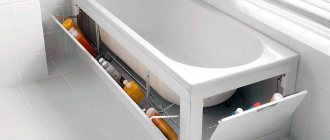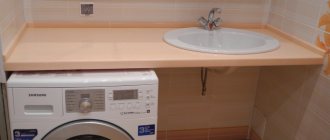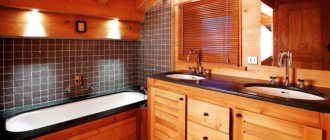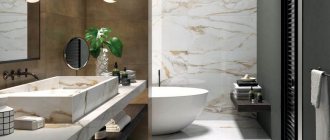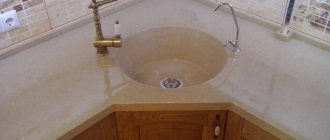What are cast iron, steel and acrylic bathtubs?
Cast iron
Durable and reliable products made of cast iron (an alloy of iron and carbon) that retain heat well were the very first to appear. And this happened in 1925, in Spain, near Barcelona. The Roca brothers decided to expand the range of their plant producing cast iron radiators by starting production of cast iron bathtubs. To this day, ROCA is one of the recognized world leaders in this area. The products of this brand are distinguished by high quality, durability and a variety of colors.
In Europe, there is a noticeable decrease in the total number of cast iron products; they are gradually being replaced by steel baths, which are easier to transport, cheaper and more environmentally friendly to manufacture. Only a few companies produce cast iron bathtubs. The most famous are Jacob Delafon, PORCHER, and ROCA. In Russia and other CIS countries they are still produced in large quantities, but in only a couple of standard sizes, and also with a small selection of shades.
Note that European cast iron products have a more beautiful and varied design. For example, there may be handles on the side or armrests, the bottom is increased by changing the angle of one of the backs. Sometimes one backrest is removed altogether for convenience. And the design of imported products can be anything: from classic with the possibility of embedding to luxurious English style.
A properly made cast iron bathtub should have walls of at least 0.5 centimeters and strong enamel, applied at the factory in two steps. The cast iron alloy contains certain amounts of manganese, silicon or sulfur, which give it additional strength. The enamel coating can last from 10 to 30 years, possibly longer (depending on the load).
+ Pros of cast iron baths
- Huge service life (up to half a century);
- Resistance to aggressive influences;
- Heat retention;
- No pores on the surface;
- Silence;
- Color depth;
- Easy to clean.
— Disadvantages of cast iron baths
- Heavy weight;
- Difficult to transport, carry for installation and install;
- Lack of variety in configurations. They can only be made rectangular or oval.
Steel
In terms of cost, a steel bathtub is more attractive than a cast iron one. Moreover, the price may differ by two or three times. This is sometimes a powerful argument when deciding which bathtub is better - cast iron or steel. In addition, many consumers like that products made of steel can take almost any shape. In addition to the traditional rectangular and oval (like cast iron), these are very convenient and compact corner designs, as well as polygonal, round, and asymmetrical.
Similar products are made from steel sheets with a thickness of 0.23 centimeters (thin-walled bathtubs) to 0.35 centimeters (standard bathtubs). The acrylic-based enamel that covers the surface of steel is less thick than that of cast iron. But modern technologies for its application make it possible to create a fairly reliable and durable coating.
Among the foreign companies producing high-quality steel products, we can note the Finnish company Ido, the French - Porcher and Jacob Delafon, the German - Bamberger and Kaldewei, the Italian - Ariston, the Spanish - ROCA. They weigh from 25 to 30 kilograms, are elegant in design and have a good enamel coating. Bamberger especially uses a lot of innovative technologies. For example, “Anti-slip” coating, which prevents slipping, “Enamel-plus”, which repels dirt. The warranty on bathtubs is 30 years.
+ Advantages of steel bathtubs
- Not too high a price;
- Variety of shapes and sizes;
- Wear-resistant coating;
- Light weight.
— Disadvantages of steel bathtubs
- They do not hold heat as well as cast iron;
- Too “loud” (the ringing noise of water being poured is clearly audible);
- Able to bend under the body of a heavy person.
Acrylic
This material began to be used for the production of bathtubs later. Its full name is methyl acrylate. It is a synthetic polymer and is made from acrylic acid. The result is a substance that is resistant to abrasion, ultraviolet radiation and oxygen. Its surface is pleasant, smooth and warm to the touch.
To make a bathtub from acrylic, use one of two methods:
- They take an acrylic sheet of the appropriate size, and then bend it in a vacuum chamber as needed. The resulting container is not very strong: its walls bend easily, and when pouring water they may swell. Therefore, the bathtub needs to be strengthened: its surface is coated with epoxy resin in several layers, lined with fiberglass. The more layers, the stronger the bathtub.
- Molding technology involves the use of a fiberglass frame onto which acrylic is applied. The result is an immediately more durable product than one made using the method described above.
In any case, a “correct” acrylic bathtub should have a wall thickness of at least 4-6 millimeters. When you tap on its sides, the sound should not be too loud. This may mean that the manufacturer cheated by deciding to save on the reinforcement process. Next, we will mention manufacturers who produce high-quality acrylic products. These are the Czech company Ravak, Polish - Cersanit and Kolo, Spanish - Pool Spa, Dutch - Riho, German - Duravit, Russian - Aquanet.
When, before arranging his bathroom, the owner of the apartment decides which bathtub is better - acrylic or cast iron, he often outweighs acrylic. Because of its lightness, beautiful and varied shape.
Construction of an acrylic bathtub and its frame.
+ Pros of acrylic bathtubs
- Acrylic retains heat well;
- The abundance of all kinds of modern devices (for example, hydromassage) makes acrylic bathtubs one of the most functional;
- Light weight;
- Huge selection of shapes and sizes.
— Disadvantages of acrylic bathtubs
- Difficulty in care;
- May sag during use;
- Fear of acrylic at too high temperatures;
- Short service life compared to cast iron and steel models.
Advantages and disadvantages of polymer baths
The acrylic bathtub attracts attention with its ergonomic shape and sparkling, flawlessly smooth bowl. Among other advantages of polymer models it is worth noting:
- light weight even for large products;
- high strength;
- the presence of a metal frame that increases the stability of the structure;
- spectacular gloss;
- pleasant to the touch and non-slip surface;
- excellent noise absorption;
- ease of maintenance and maintainability;
- long-term heat retention.
Hydromassage acrylic bathtubs are simply a godsend. Fans of the relaxing effects of air bubbles have no doubt which is better in terms of functionality: acrylic or cast iron. Only polymer models with nozzles for elastic water jets can provide wonderful conditions for relaxation. A Jacuzzi transforms your bathroom into a comfortable home spa.
The curved internal surfaces of the containers amaze with the complexity and originality of their lines. At the same time, hygienic and heat-resistant acrylic does not absorb dirt and is easy to clean. A perfectly smooth surface eliminates the possibility of bacterial growth. With proper care, the acrylic model will retain its original bright gloss for a long time.
Problems with a polymer bath can only arise as a result of improper use. Using abrasive cleaners may cause abrasions and scratches. You should not wash colored linens or bathe large four-legged pets in the bathtub. The color of an acrylic bowl may lose its snow-white color when exposed to clothing dyes and imperfect tap water.
When the container is filled with water to the brim, the polymer bath “holds its shape” worse than other models. Therefore, to increase static strength, the structure is installed on a strong frame. After a strong impact or falling weight, acrylic may crack. In this case, complete restoration of the coating at home is possible. Small scratches, sanded and polished, disappear from the surface of the bowl without a trace.
Easy to install
Bringing a heavy cast-iron bathtub into the house is not so easy - one person cannot do it. This explains the difficulty in installing such products. They also need to be firmly fixed on a flat plane. They are usually placed on four cast legs.
To install an acrylic bathtub, you will need to assemble a metal frame and only after installing the bathtub on the frame can it be connected to the sewerage system. This makes the installation process somewhat difficult, but since all the parts are light, one person can handle it quite well.
Steel bathtubs are also fixed on legs, but their installation can be done by one person. To significantly increase sound insulation, a layer of polyurethane foam is often applied to the surface of the product or the bottom is covered with Penofol. In general, installation of a steel bathtub is the easiest.
Sound insulation of a steel bath: on the left with Penofol, on the right with polyurethane foam.
Steel bath
Acrylic bath
Cast iron bath
Results. Steel bathtubs can be called the easiest to install (however, in the case of applying polyurethane foam, the process becomes somewhat more complicated). The second place belongs to acrylic bathtubs, where you will have to tinker with making the frame. And the rating is completed by cast iron products, heavy and bulky.
Easy to care for
If the enamel is applied to cast iron with high quality and has a sufficiently thick layer, then the coating is very durable. And even if the stain has penetrated deep into the enamel, it can be removed in almost any way, including chemical reagents and mechanical action. And housewives do this with great success.
Steel products are coated with thinner enamel, which, accordingly, needs to be cleaned more carefully than in the previous case. Especially when using abrasive products. Otherwise, you can damage the surface, which will be difficult to restore later.
Acrylic bathtubs are cleaned carefully, using mild care products and without using strong abrasives or aggressive chemicals. This will prevent the formation of cracks and premature failure of the product.
Cast iron bath
Steel bath
Acrylic bath
Results. On this point, our products made of cast iron turned out to be the most unpretentious, and acrylic ones modestly retreated to the very last place, third. Steel baths took the middle position. However, the steel models mentioned above, coated with the innovative “Enamel-plus” composition, can also very well lay claim to the position of leader in ease of maintenance.
What is better to choose
Each owner must make a decision about purchasing a bathtub based on his financial capabilities, operating conditions and room dimensions, and the desired characteristics of the plumbing equipment.
For modest-sized rooms, it is preferable to choose products made of steel or cast iron of standard shapes and sizes. If the space of the room allows, you can purchase models made of acrylic or cast iron of various shapes with additional features (hydromassage, automatic water level adjustment).
Life time
It’s not for nothing that cast iron products are still popular - after all, they are destined to please their owners for at least 50 years, and this is a very decent period. Steel bathtubs can safely last 20-30 years. Products made from cast acrylic last for at least 15 years. But provided that their walls have a thickness of at least 4 - 5 millimeters.
Cast iron bath
Steel bath
Acrylic bath
Results. Cast iron has firmly established itself in our leading position - its durability is beyond doubt (but technology must be followed in the manufacture of this material). Steel bathtubs are again in the middle of the ranking, and acrylic products are in last position.
Disadvantages to consider
The negative qualities of a cast iron bathtub include bulkiness and heavy weight, and this affects the process of dismantling, transportation and installation, creating certain inconveniences. Often bathtubs from foreign manufacturers have less weight. This is due to the fact that imported cast iron bathtubs have smaller wall thicknesses. The quality does not suffer from this, but the weight does not decrease much.
The vulnerable part in a cast iron bathtub is the enamel, no matter how special it is. If something heavy hits the inner surface of the bathtub, enamel particles may be knocked off. Restoring the bathtub coating yourself is an impossible task. In addition, over a long service life, the enamel gradually wears off and darkens.
Due to the fact that cast iron casting is a rather labor-intensive process, bathtubs are designed in a classic style. But among them you can also find avant-garde cast iron bathtubs. Usually these are plumbing fixtures from foreign manufacturers.
If you need a bathtub with lighting and hydromassage, and you have to choose acrylic or cast iron, then it is worth remembering that installing a cast iron bathtub is more complicated than an acrylic hydromassage bathtub.
The service life of a cast iron bathtub can be very long, provided that the enamel coating is handled with care. See more about the advantages of cast iron bathtubs here.
Degree of coating protection
This point is quite closely related to product care, so let’s repeat it a little. As already mentioned, the enamel used to cover cast iron is distinguished by a smooth surface, resistance to various reagents and mechanical stress. When making high-quality cast iron bathtubs, specialists carefully check the quality of the enamel at each stage, applying it in a layer of 0.8 to 1.2 millimeters. Firing occurs at a temperature of 110 degrees. So the protection of such a bath is “one hundred percent.”
The enamel on steel bathtubs is also of good quality, but due to its thinner layer, the protective coating is somewhat less reliable than in cast iron products.
Acrylic is quite fragile; it does not like having something heavy thrown on it. Because of this, cracks may appear. Which, of course, are quite amenable to restoration, but all this adds trouble. In addition, stains from various dyes and scratches very easily remain on the surface of acrylic. Of all the coatings, acrylic should be treated most sparingly.
Cast iron bath
Steel bath
Acrylic bath
Results. And again the team with cast iron bathtubs wins the gold medal; second place, according to tradition, goes to steel bathtubs; third place goes to acrylic bathtubs.
What care does a cast iron bath need?
To maintain the coating for many years, it is necessary to carry out proper care. Here are some tips to help with daily care:
- Every time after using the bathtub, wash it with a sponge and non-abrasive detergent;
- After rinsing with running water, you need to wipe the bath dry;
- Soap foam can easily remove fresh stains;
- Old stains can be removed using vinegar, ordinary soda, laundry soap or bleach. For modern cast iron products with very durable non-porous enamel, this method is also suitable;
- It must be remembered that to clean the bathtub it is strictly forbidden to use products with abrasive components, as well as acid-based solutions, brushes with metal bristles and blades;
- Heavy dirt and rust can be removed using special products purchased at any store.
Variety of sizes
Cast iron bathtubs made in Europe can have a length from 150 to 180 centimeters and a width from 60 to 90 centimeters. The standard length of the lower (inner) part is 110-120 centimeters. Modern technologies (changing the angle of the backrest, for example) make it possible to increase this size to 130-140 centimeters. Domestic cast iron bathtubs are made with a width of 70 centimeters and a length varying from 120 to 150 centimeters.
The variety of shapes of steel and acrylic products also implies a variety of sizes. As an example, let's take steel baths produced by the German company Kaldewei. The large model of this brand, Corpostar, has dimensions of 190 by 90 centimeters, and the small Miniform model has dimensions of 157 by 70 centimeters. The Japanese-style Kusatsu Pool model is distinguished by its increased depth (81 centimeters) and compactness (140 by 100 centimeters).
Bathtubs made from acrylic are equally varied in size. They can be large and small, wide and narrow, deep and not very deep. Corner and round options are available with different side sizes and diameters. If we talk about rectangular and oval models, their bowl can have a width from 70 to 170 centimeters, and a length from 120 to 190 centimeters.
Acrylic bath
Steel bath
Cast iron bath
Results. More modern steel and acrylic are again in the lead, leaving behind the good-quality but conservative cast iron. They make it possible to choose a product for any bathroom and for any purpose. For example, a large round bathtub can easily be used for two people at once. A compact corner option is for a small apartment.
Installation types
There can be three options: installation along one of the walls (the most common), corner placement and installation in the middle of the room. The latter option is used for large bathrooms when using large oval or round bathtubs. Which are often equipped with hydromassage and other pleasant extras.
Corner models are produced both symmetrically and with different sizes of sides adjacent to the walls. As a rule, the side opposite the corner is rounded. It is not only practical, but also looks beautiful.
Cast iron bathtubs, as a rule, are placed along the wall, less often they are placed in the center of the room. Due to the design features, they cannot be installed in a corner. As for steel and acrylic products, they can be mounted in any of three options. Finding the right model is not a problem.
Acrylic bath
Steel bath
Cast iron bath
Results. Once again we have two leaders - steel and acrylic products have more options regarding the type of installation. The cast iron baths remained in the shadows.
Something about disadvantages
One cannot, of course, ignore the disadvantages that steel bathtubs have. One of the disadvantages is thin walls, which can become deformed under excessive load, which, in turn, will contribute to the appearance of chips and cracks on the enamel surface. Thin-walled steel bathtubs have a fairly low price, but those products that have a higher cost and, accordingly, thick walls, are almost impossible to deform. The guaranteed service life of such a container is much longer. It is best to choose a steel bath with a wall thickness of 3 mm or more.
A steel bathtub retains heat worse than a cast iron one, and the water poured into it cools down faster. This process occurs faster in a thin-walled bath.
Also, when filling water into a thin-walled steel bathtub, a humming noise is heard, which causes discomfort. In order to avoid this, foreign manufacturers attach sound insulation gaskets to the outer surface of the bathtub; this partially solves the problem.
You can eliminate the inconvenience of the noise produced by installing the bathtub in a base made of bricks and lined with ceramic tiles.
If the choice is made in favor of a steel enameled bathtub, then when purchasing it you should lift or move it. If it is easy to move, and its weight is within 25 kg, it only means that its walls are thin and may become deformed. A durable steel enameled bathtub usually weighs between 30 and 50 kg.
When faced with the choice of which bathtub (steel or cast iron) will decorate the bathroom, you need to take into account that the cost of cheap steel models is not much less than economy class cast iron options. See more about steel bathtubs here.
Ease of use
Here we will consider what degree of comfort products made from various materials give us. Let's start with the temperature of the water - for a pleasant swim it is important that it does not cool down longer. Good old cast iron is very good in this sense - it keeps water warm for a long time. However, modern acrylic can also boast of good heat conservation. But steel - alas - quickly cools water. In addition, it has another drawback - it rattles loudly when the bath is filled. Cast iron and acrylic are very quiet.
Bathroom walls made of cast iron will never sag. Now let’s look at the following two products based on this parameter, determining which bathtub is better—an acrylic or a steel bathtub. Steel can easily hold its position without sagging under the weight of the body, which cannot be said about acrylic. Deflection of the walls is its main drawback; the metal frame on which the bathtub is mounted is designed to cope with it. This is most relevant for overweight people.
Cast iron bath
Acrylic bath
Steel bath
Results. According to the parameters under consideration, the most convenient are cast iron products. Acrylics are not without drawbacks in this regard, so they can share second place. Steel bathtubs are somewhat inferior to acrylic bathtubs in this regard, but in some cases they can perform on an equal footing. Also, bathtubs made of steel and acrylic are often equipped with all sorts of comfortable seats, handles, and armrests.
How to choose the right steel bathtub
If we talk about cost, then, as many buyers say in their reviews, it is the most acceptable for steel bathtubs, which gives rise to such high demand. But you should not think that this indicates its inferiority in relation to other products - it has its advantages.
Steel bath
Steel is a non-porous, lightweight material. Such properties help reduce the cost of applying enamel. When dried at high temperatures, the enamel can penetrate 1/3 of the micropores of the product, which suggests that the bathtub is resistant to various types of acids and other abrasive substances. In addition, such products have high wear resistance and impact resistance.
If you compare an acrylic and a steel bathtub to make a choice, then for a steel product you need to pay attention to the following points:
- the average thickness of the walls of the product must be at least 3-4 mm, otherwise there is a risk of its deformation even under the weight of a person;
- the weight of the product itself reaches 30-40 kilograms; if it is lighter, it will not be able to withstand the weight of a person, and the enamel will crack due to deformation;
- the coating must be of high quality;
- the bathtub should have a warranty of about 10 years;
- the normal depth of the bathroom should be 50-60cm, it should be low enough so that you can wash yourself while half-sitting;
- the optimal length of the bath is 160-170 cm, but much depends on the person’s height.
A steel bathtub is no less attractive than an acrylic one, since it is covered with enamel, and in appearance it can be somewhat similar to cast iron; it can actually be difficult to distinguish them. But a comparison of cast iron and steel bathtubs should be carried out only after familiarization with the features of cast iron products.
Device weight
The heaviest are bathtubs made of cast iron. They weigh at least 120-130 kilograms. Such a significant weight (sometimes reaching up to 150 kilograms) provides good stability, but significantly complicates installation work. Which will cost more than installing a steel or acrylic bathtub.
A European-made steel bathtub with walls from 2.5 to 3 millimeters is much lighter than a cast iron one, several times lighter. Her weight is approximately 25 to 30 kilograms.
The most “weightless” material can be called acrylic. If a bathtub made from it has a length of 150 centimeters, then its weight ranges from 15 to 20 kilograms. Products with a length of 170 centimeters weigh from 20 to 25 kilograms. By the way, when purchasing, pay attention to this: a bath that is too light, and whose weight differs greatly from these indicators, may turn out to be of poor quality. Otherwise, the manufacturer cheated by making a product with fewer reinforcing layers than it should have.
Acrylic bath
Steel bath
Cast iron bath
Results. In first place we will define acrylic products. On the second - steel baths, and on the third - cast iron, completely heavy.
Choosing a truly eco-friendly bath without styrene
If you do not keep the finished acrylic bathtub for the required amount of time at a temperature of 45 degrees, then its reinforcing layer will become dangerous to humans. After drying, such baths have a specific smell that does not disappear even after three months. During operation, the product will release a toxic substance - styrene.
Some manufacturers use a safer method of reinforcing bathtubs - the use of soundproofing polyurethane foam composite, which has high noise and thermal insulation. Acrylic bathtubs reinforced with polyurethane foam are easy to distinguish from others: on the outside they are “painted” green.
Acrylic is better than ABS
Many people confuse different concepts, calling acrylic bathtubs products made from ABS, plastic or papier-mâché. Bathtubs made of 100% acrylic should be distinguished from low-quality analogues: structures made of extruded acrylic (ABS) or combined polymers.
The first consists of three layers:
- top (acrylic only 1 mm thick);
- medium (porous plastic);
- bottom (plastic with a 0.5 mm thick reinforcing material applied to it).
After a short period of use, bathtubs made of ABS/PMMA become covered with small cracks in the areas where hydromassage nozzles are installed or where drains are installed. This is caused by different thermal conductivities of materials when the bath is heated from water or cooled.
Paradoxical as it may seem, there are also plastic bathtubs made from a whole sheet of this component with a thickness of 5 mm or more. This is a cheap, easy-to-form soft material that quickly loses its glossy surface. In Europe, the production of plastic bathtubs is prohibited.
Products made using the papier-mâché method cannot be called high-quality, since they only superficially resemble a real acrylic bathtub. The basis of the bathtub here is ordinary thick cardboard, which is covered with several layers of acrylic paint and reinforced with fiberglass.
What is the difference between a real acrylic bathtub and cheap fakes?
- The thickness of the acrylic sheet is 5mm;
- supplied on a frame with adjustable legs;
- the bathtub has an anatomical shape without intricate shapes;
- the price starts from 15 thousand rubles;
- During operation, the surface never turns yellow and retains its shine.
Price
Let's start again with cast iron appliances. Domestic models without any special bells and whistles will cost $50-70. European baths will cost more: $200 and up. The price for premium collections from PORCHER and Jacob Delafon can reach up to $450-700.
Bathtubs made of steel cost twice (or even three times) less than cast iron ones. If we talk about European products, their price will start from 100 dollars. Products from Russian manufacturers will cost from $50.
Acrylic devices have a very wide price range. Moreover, they are often equipped with a hydromassage system, which should also be taken into account when comparing the cost of different types of baths. The most budget option will cost from $60 (made in China). Russian products will cost from $100, European ones – $130-200.
Steel bath
Acrylic bath
Cast iron bath
Results. The first place in terms of cheapness rightfully belongs to steel bathtubs. In second place are acrylic products. Cast iron completes the ranking.
Cost and additional expenses
The average cost of a domestically produced cast iron bathtub is $220 or more. European brand models will cost from $350. For improved designs with minimal features to improve comfort - handles, anti-slip coating, etc. you will have to pay from 500 dollars. The price of premium class models is even higher; there are bathtubs for 1.5-3 thousand.
For comparison, a budget steel structure will cost only 85 USD. Moreover, the pricing policies of domestic and foreign manufacturers are not particularly different. The extended comfort class option is also not much different in price from the standard models - only 115 USD. True, elite baths are expensive - from 1.5 to 5 thousand.
It is difficult to draw a clear conclusion which bathtub is better, acrylic cast iron or steel. Each option has its pros and cons. Cast iron models are simple in appearance, but durable and strong. From steel variations, you can choose an original bathtub of unusual design and color.
It is important to make a choice, focusing on your priorities and what matters in your case: price, weight, ease of installation, shape, etc. Cast iron bathtubs are a reliable classic. Steel products are a kind of budget compromise with average characteristics.
Final comparison of cast iron, steel and acrylic bathtubs by parameters
| STEEL BATHTUBES | ACRYLIC BATHTUBES | CAST IRON BATHTUBES | |||||||
| Easy to install | 9/10 | 8/10 | 7/10 | ||||||
| Care | 8/10 | 7/10 | 9/10 | ||||||
| Life time | 9/10 | 7/10 | 10/10 | ||||||
| Degree of coating protection | 8/10 | 7/10 | 9/10 | ||||||
| Variety of shapes | 9/10 | 10/10 | 7/10 | ||||||
| Variety of sizes | 9/10 | 10/10 | 8/10 | ||||||
| Installation types | 10/10 | 10/10 | 8/10 | ||||||
| Ease of use | 8/10 | 9/10 | 10/10 | ||||||
| Device weight | 9/10 | 10/10 | 6/10 | ||||||
| Price | 10/10 | 9/10 | 8/10 | ||||||
If you notice an error, a non-working video or link, please select a piece of text and press Ctrl+Enter .
0

